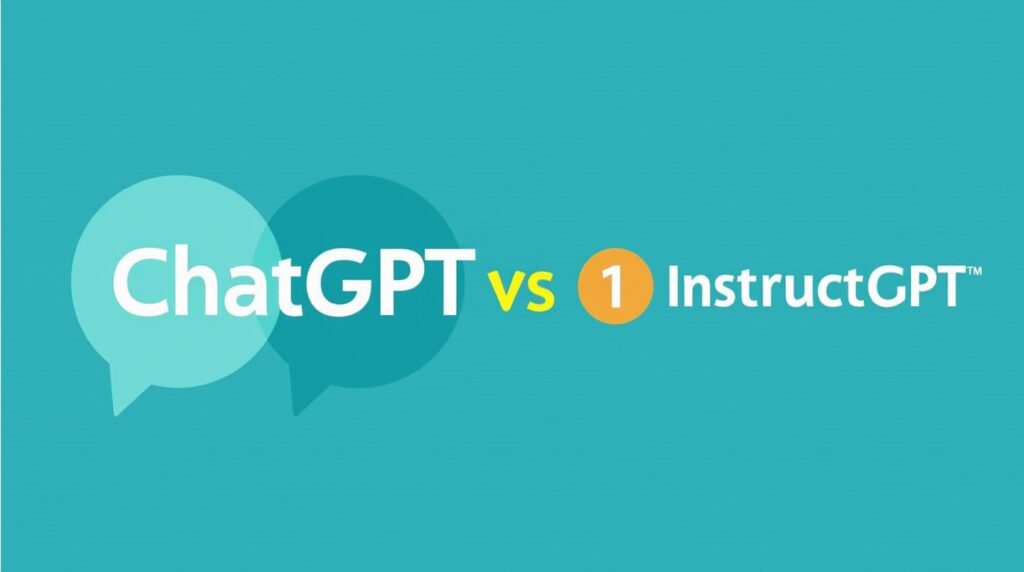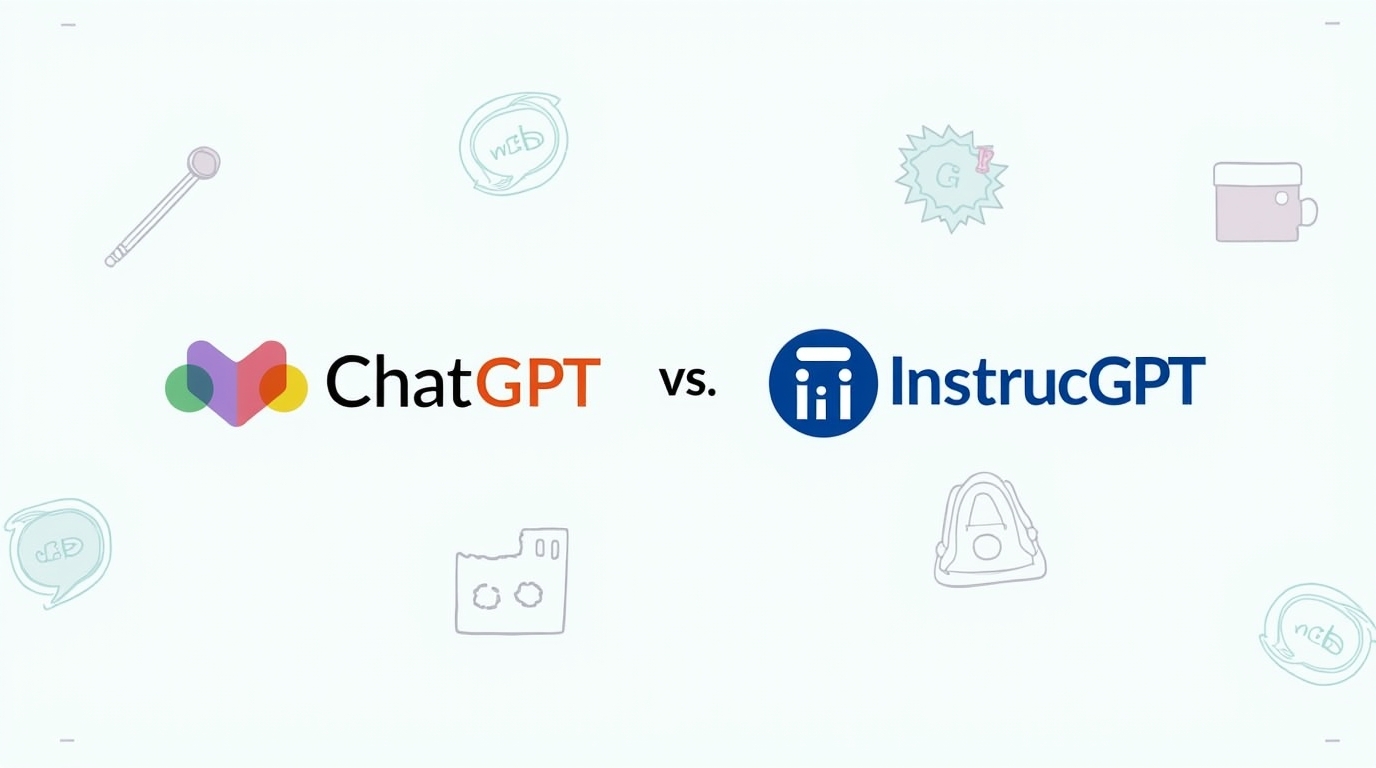Artificial intelligence has changed how we interact with technology. Two important models from OpenAI stand out: ChatGPT and InstructGPT. While they share similarities, these AI systems serve different purposes and work in unique ways.
Understanding the differences between ChatGPT and InstructGPT helps you choose the right tool for your needs. This guide explains everything you need to know about both models.

What Is InstructGPT?
InstructGPT is a sibling model to ChatGPT, which is trained to follow an instruction in a prompt and provide a detailed response. InstructGPT is a fine-tuned version of GPT3.
The model was designed to solve a specific problem. Making language models bigger does not inherently make them better at following a user’s intent. Large language models often generate outputs that are unhelpful, toxic, or simply wrong.
InstructGPT addresses this issue through a special training method called Reinforcement Learning from Human Feedback (RLHF). InstructGPT uses a human feedback approach in the fine-tuning process, where humans show a set of outputs to the GPT model once it has been pre-trained through the InstructGPT framework.
Key Features of InstructGPT:
- Follows instructions precisely
- Provides detailed responses to specific prompts
- Trained using human feedback methods
- Built on GPT-3 foundation
- Focuses on accuracy and helpfulness
What Is ChatGPT?
ChatGPT is the conversational AI that took the world by storm in late 2022. Picture ChatGPT as a social butterfly, trained to be the life of any conversation. This model excels at maintaining long conversations on almost any topic.
ChatGPT is a sibling model to InstructGPT, but it’s designed for different purposes. While InstructGPT focuses on following instructions, ChatGPT prioritizes natural conversation flow and engagement.
Key Features of ChatGPT:
- Excellent conversational abilities
- Maintains context across long chats
- Generates creative content
- Handles multiple topics in one conversation
- User-friendly interface
Core Differences Between ChatGPT and InstructGPT

1. Primary Purpose
InstructGPT is designed for natural language processing tasks in specific domains, while ChatGPT is designed for conversational contexts.
InstructGPT works best when you need:
- Specific task completion
- Precise instruction following
- Domain-specific responses
- Single-turn interactions
ChatGPT excels when you want:
- Natural conversations
- Creative discussions
- Multi-topic interactions
- Extended dialogues
2. Training Data and Methods
InstructGPT was trained on a dataset of 1.6 trillion words, while ChatGPT was trained on a dataset of 45 terabytes of text and code. This difference in training data size affects their capabilities.
Both models use the Transformer architecture, but their training approaches differ:
InstructGPT Training:
- Uses RLHF (Reinforcement Learning from Human Feedback)
- OpenAI used the prompts submitted by its customers to the API as human feedback. The prompts were annotated and added to the training set to fine-tune GPT-3.
- Focuses on instruction-following accuracy
- Emphasizes helpful, harmless, and honest responses
ChatGPT Training:
- Built on InstructGPT’s foundation
- Additional training for conversation flow
- More diverse training data
- Better at maintaining context across turns
3. Response Style and Behavior
InstructGPT:
- More formal and structured responses
- Focuses on completing specific tasks
- Less conversational tone
- Direct and to-the-point answers
ChatGPT:
- Natural, conversational responses
- Adapts to user’s communication style
- More creative and flexible
- Maintains personality across conversations
4. Use Cases and Applications
Best Uses for InstructGPT:
- Content summarization
- Data analysis tasks
- Code generation for specific functions
- Technical documentation
- Precise question answering
Best Uses for ChatGPT:
- Customer service chatbots
- Educational tutoring
- Creative writing assistance
- Brainstorming sessions
- General conversation and support
Technical Architecture Comparison
Model Foundation
Both models share the same underlying architecture but differ in implementation:
Shared Elements:
- Transformer neural network architecture
- Large-scale language modeling
- Pre-training on massive text datasets
- Fine-tuning capabilities
Different Elements:
- Training objectives
- Reward model implementation
- Human feedback integration
- Output formatting
Performance Metrics
The resulting InstructGPT model was more performant in following instructions than the base GPT-3 model. However, performance depends on the specific task:
InstructGPT Advantages:
- Better instruction following
- More accurate task completion
- Reduced harmful outputs
- Higher alignment with user intent
ChatGPT Advantages:
- Better conversation flow
- More engaging responses
- Superior creative abilities
- Better context retention
When to Choose Each Model
Choose InstructGPT When:
- You need precise instruction following
- Working on specific, well-defined tasks
- Require consistent, structured outputs
- Focus on accuracy over creativity
- Building automated systems
Choose ChatGPT When:
- You want natural conversations
- Need creative assistance
- Require multi-turn interactions
- Want engaging user experiences
- Building customer-facing applications
Impact on AI Development
One of the key differences of ChatGPT with previous models is its ability to follow instructions. This is powered by another model called InstructGPT which OpenAI quietly unveiled at the beginning of the year.
InstructGPT, thus, is the underlying stack that sits beneath ChatGPT. This relationship shows how AI development builds upon previous innovations.
Industry Influence
Both models have significantly influenced AI development:
InstructGPT’s Contributions:
- Established RLHF as a standard training method
- Improved AI safety and alignment
- Set new standards for instruction following
- Influenced other AI companies’ approaches
ChatGPT’s Impact:
- Popularized conversational AI
- Increased public AI awareness
- Drove commercial AI adoption
- Inspired competitor development
Future Considerations
The relationship between these models continues to evolve. RLHF has since been used in the training of state-of-the-art LLMs from OpenAI, DeepMind, Google and Anthropic.
Understanding both models helps you:
- Make informed decisions about AI tool selection
- Understand current AI capabilities and limitations
- Prepare for future AI developments
- Choose appropriate applications for your needs
Final Thoughts
The development of both ChatGPT and InstructGPT represents a significant milestone in AI history. These models demonstrate how different training approaches can create AI systems suited for different purposes. As AI technology continues to advance, understanding these foundational differences will help you navigate the expanding world of artificial intelligence tools and applications.
